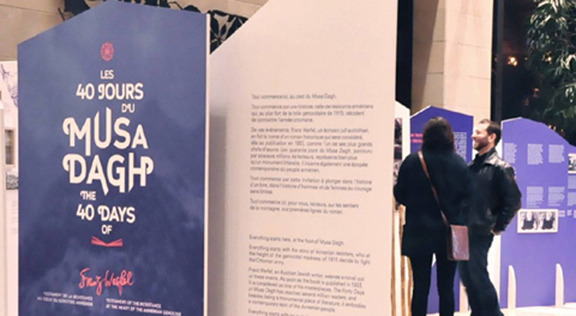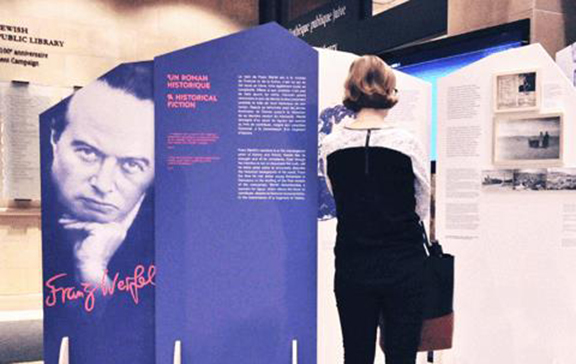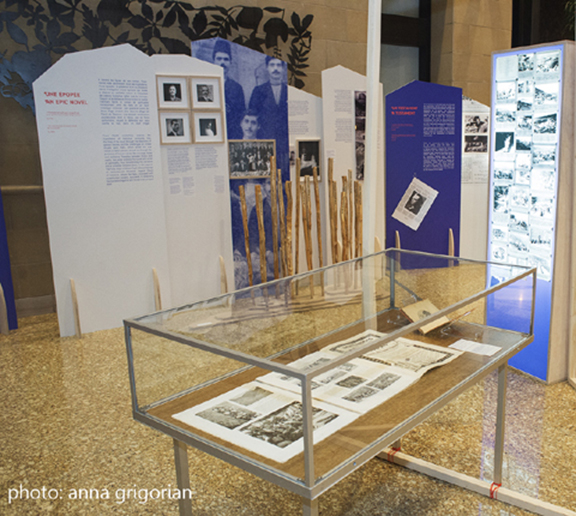BY MICHAEL ARTY GHANNOUM
MONTREAL (Horizon Weekly) — “I have been impressed with the urgency of doing, knowing is not enough; we must apply. Being willing is not enough; we must do.” When Leonardo Da Vinci spoke these words, he was referring to his need to materialize his imagination. Undoubtedly so, the late inventor was not referring to any ethnic or cultural pursuit, rather the necessity for developing what one believes in. As a community, beliefs are pursued together, and as the recent events surrounding the commemoration of the 100thanniversary of the Armenian Genocide reveal, the will to share such a history has created a new generation of storytellers that use the tools of the past to mark the imagination of the future.
A few months ago I received an invitation to attend an exhibit at the Montreal Holocaust Memorial Center, a museum situated in the NDG neighborhood. The exhibit, “The Forty Days of Musa Dagh: Testament of the resistance at the heart of the Armenian Genocide”, was organized by a subcommittee of the Armenian Genocide Centennial Committee of Canada headed by Aram Elagoz, Mher Karakachian and Dr. Der Kaloustian –later joined by Marie-Blanche Fourcade, Maïa Djambazian and Lori Baltazar. The project presents a walking story of the epic novel The Forty Days of Musa Dagh by Austrian-Jewish author Franz Werfel, using the journey of the author and of the book itself as doorways into the story of the Armenians of Musa Dagh.
Arguably one of the most iconic events during the years of the genocide, the book recounts the battles and hardships the inhabitants of Musa Dagh encountered, during a Turkish siege lasting 53 days. When the book was released in Germany of 1933, it became one of the most powerful literary symbols for those who found themselves, like the Armenians, surrounded by a larger than life enemy who wanted nothing less than their complete annihilation. The idea of a book came when Werfel encountered Armenian orphans while traveling through Syria in the early 1920s. Although he had never been to Musa Dagh, his ability to accurately depict sceneries, characters and such narratives as sacrifice, defiance, and faith in the book, was made possible by the stories he heard from witnesses as well as thorough research he conducted through archives centers and libraries around Europe. The President of the Armenian Genocide Centennial Committee of Canada, Mher Karakachian, understood the importance of building bridges between communities and so approached, five years ago, the Montreal Holocaust Memorial Center with the idea of putting together an exhibition about the novel. He knew the book constituted, in more ways than one, a meeting ground between the Armenian and the Jewish communities. And the museum agreed to house this ambitious project and participate in its development. In the end, what better way to strengthen our ties for the future, if we do not share the pain of the past?
As the panels of the exhibit demonstrate, the beauty of the story is not limited to its climactic ending, with the French navy evacuating the resistors of Musa Dagh, its powerful themes of resistance, resilience, and rebirth propel the story from a novel, to the bearings of a historical epic. More than a book, as the exhibit illustriously demonstrates, The Forty Days of Musa Dagh, became a beacon of hope for those caught with their back against the sea, and their eyes facing the desert.
What we learn at the entrance of the exhibit is that the escaping families were brought by the French navy to Port Said in Egypt and stayed in temporary camps for 4 years, until they returned to their homes in Musa Dagh for the following 20 years. Unfortunately, history often deals the same hand, and for these families, that meant leaving their homes a second time and finding refuge from persecution in the harsh slums of Anjar, Lebanon. However, the community not only rebuilt itself, but birthed some of the most influential leaders of the Armenian Diaspora, with the tenacity and courage of their forefathers driving their engagement for the Armenian cause.
Marie-Blanche Fourcade and Maïa Djambazian, the two museologists and project managers of the exhibit, worked hard at bridging the gap between the community’s vision for the project, and the necessary communicational and functional needs for these types of displays. Moreover, Fourcade’s experience as an ethnologist and museum professional, as well as her long-standing interest in the heritage of the Armenian community in Quebec, are undoubtedly reflected in her approach to the project and the tone used for the exhibition texts. Throughout my years, I have noticed that many Armenian cultural displays often house overtones of hostility towards the Turkish government, and although this is without a doubt justifiable, it has a tendency to dilute intellectual value of the materials when presented to a public who is unfamiliar with the topic. This exhibit however, does not for a moment allow the viewer to think of it as a radicalized or skewed perspective of history.
The exhibit presents a series of panels, cleverly reproducing a mountainous profile, designed by graphic and exhibition designer Gaël Dorgère. Each section serves to articulate the multiple subthemes using the multiple literary genres embodied by the book –i.e. Historical narrative; Historical novel; Epic novel; Testament— as doorways.
A large part of the documents displayed were lent by Dr. Der Kaloustian, son of Movses Der Kaloustian, one of the leaders of the rebellion, who is said to have inspired the main character of Gabriel Bagradian in Werfel’s novel. To complete Dr. Der Kaloustian’s contribution from his personal collection, and go past an evident absence of physical material related to this resistance, the organizers reached out to institutions and collaborators from around the world in order to enrich and vary the types of documents presented. The Armenian Genocide Museum-Institute, the University of Pennsylvania Libraries, the Online Archives of California, the Austrian National Library, the Armin Wegner Foundation and the United States Department of State Archive are just a few which have contributed to this collaborative project. When I asked Djambazian what were the difficulties of bringing history and fiction so close together, she said the biggest challenge was to respect the memory of this story that each descendant had constructed for himself, and to balance the different thematic orientations and visions each collaborator intended for the project. As the organizers had their own specific personal implication and relation to the story as well as numerous technical and communicational preoccupations, managing opinions, ideas, and interests was no easy task. They opted to go for a more romanticized depiction of the events by using a series of original visual elements such as a first edition of the book in German, family photos from the early 20th century, Gustave Dore’s biblical engravings, as well as a micro-documentary filmed and edited by Alina Gotcherian. The latter compiles interviews featuring testimonies of now Canada-based descendants of the resistors of Musa Dagh and will possibly be part of a larger project that will be available for the public soon.
When discussing the next steps, Djambazian said that the organizers are already in negotiation with several institutions in North America and around the world to make the exhibit travel despite the slowing down of the Centennial events. With a whole slew of new possibilities, a new group of allies, and a community supporting the development of truth, the Musa Dagh project is far from over. This event opened my eyes to the possibilities of community work, and political activism that can be done in any way a person sees fit. As long as the integrity of history is maintained, all truths must come to light and we, as the Armenian youth of today, and the leaders of tomorrow, have a responsibility to do just that.
The exhibit goes until February 11, 2016, at 5151 Chemin de la Côte-Sainte-Catherine, Montreal.
Source: Asbarez
Link: The Genesis of a Collaborative Project: The Forty Days of Musa Dagh exhibit



